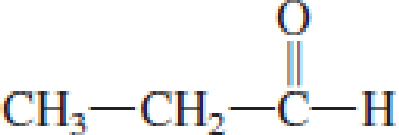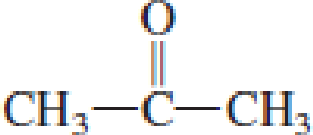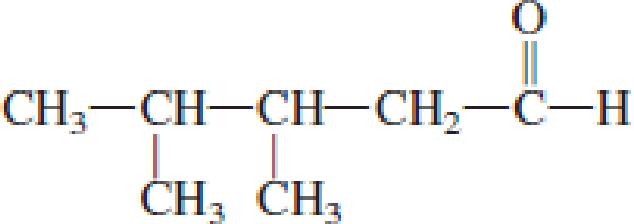
Organic And Biological Chemistry
7th Edition
ISBN: 9781305081079
Author: STOKER, H. Stephen (howard Stephen)
Publisher: Cengage Learning,
expand_more
expand_more
format_list_bulleted
Concept explainers
Textbook Question
Chapter 4, Problem 4.82EP
Which of the following compounds would react with Benedict’s solution?




Expert Solution & Answer
Want to see the full answer?
Check out a sample textbook solution
Students have asked these similar questions
What is the IP for a amino acid- give an example
what are the types of amino acids
What are the structures of proteins
The N-Terminal analysis by the Edman method shows saralasin contains sarcosine at the N-terminus. Partial hydrolysis of saralasin with dilute hydrochloric acid yields the following fragments:
Try-Val-His
Sar-Arg-Val
His-Pro-Ala
Val- Tyr- Val
Arg-Val-Tyr
What is the structure of saralasin?
>
aw the missing intermediates 1 and 2, plus the final product 3, of this synthesis:
1. Eto
1. EtO¯
H3O+
1
2
2. PrBr
2. PrBr
Δ
You can draw the three structures in any arrangement you like.
3
Click and drag to start drawing a structure.
Explanation
Check
2025 McGraw Hill LLC. All Rights Reserved. Terms of Use
Privac
There are various factors that affect an equilibrium. Give 3 of these factors and explain using examples andequations how an equilibrium is affected by these factors. Please remember that this is a communication question so that you are communicating your understanding of the factors that affect and equilibrium.
Chapter 4 Solutions
Organic And Biological Chemistry
Ch. 4.1 - Prob. 1QQCh. 4.1 - Prob. 2QQCh. 4.2 - Prob. 1QQCh. 4.2 - Prob. 2QQCh. 4.2 - Prob. 3QQCh. 4.3 - Prob. 1QQCh. 4.3 - Prob. 2QQCh. 4.3 - Prob. 3QQCh. 4.4 - Prob. 1QQCh. 4.4 - Prob. 2QQ
Ch. 4.4 - Prob. 3QQCh. 4.4 - Prob. 4QQCh. 4.4 - Prob. 5QQCh. 4.5 - Prob. 1QQCh. 4.5 - Prob. 2QQCh. 4.5 - Prob. 3QQCh. 4.5 - Prob. 4QQCh. 4.5 - Prob. 5QQCh. 4.6 - Prob. 1QQCh. 4.6 - Prob. 2QQCh. 4.6 - Prob. 3QQCh. 4.7 - Prob. 1QQCh. 4.7 - Prob. 2QQCh. 4.8 - Prob. 1QQCh. 4.8 - Prob. 2QQCh. 4.9 - Prob. 1QQCh. 4.9 - Prob. 2QQCh. 4.10 - Prob. 1QQCh. 4.10 - Prob. 2QQCh. 4.10 - Prob. 3QQCh. 4.10 - Prob. 4QQCh. 4.11 - Prob. 1QQCh. 4.11 - Prob. 2QQCh. 4.11 - Prob. 3QQCh. 4.11 - Prob. 4QQCh. 4.11 - Prob. 5QQCh. 4.12 - Prob. 1QQCh. 4.12 - Prob. 2QQCh. 4 - Prob. 4.1EPCh. 4 - Prob. 4.2EPCh. 4 - Prob. 4.3EPCh. 4 - In terms of polarity, which carbonyl group atom...Ch. 4 - Prob. 4.5EPCh. 4 - Prob. 4.6EPCh. 4 - Prob. 4.7EPCh. 4 - Prob. 4.8EPCh. 4 - Prob. 4.9EPCh. 4 - Prob. 4.10EPCh. 4 - Prob. 4.11EPCh. 4 - Classify each of the following structures as an...Ch. 4 - Prob. 4.13EPCh. 4 - Prob. 4.14EPCh. 4 - Prob. 4.15EPCh. 4 - Prob. 4.16EPCh. 4 - Prob. 4.17EPCh. 4 - Prob. 4.18EPCh. 4 - Prob. 4.19EPCh. 4 - Prob. 4.20EPCh. 4 - Prob. 4.21EPCh. 4 - Prob. 4.22EPCh. 4 - Prob. 4.23EPCh. 4 - Prob. 4.24EPCh. 4 - Prob. 4.25EPCh. 4 - Prob. 4.26EPCh. 4 - Prob. 4.27EPCh. 4 - Prob. 4.28EPCh. 4 - Name the functional group(s) present in each of...Ch. 4 - Prob. 4.30EPCh. 4 - Prob. 4.31EPCh. 4 - Prob. 4.32EPCh. 4 - Prob. 4.33EPCh. 4 - Prob. 4.34EPCh. 4 - Prob. 4.35EPCh. 4 - Prob. 4.36EPCh. 4 - Draw a structural formula for each of the...Ch. 4 - Prob. 4.38EPCh. 4 - Prob. 4.39EPCh. 4 - Prob. 4.40EPCh. 4 - Draw a structural formula for each of the...Ch. 4 - Prob. 4.42EPCh. 4 - Prob. 4.43EPCh. 4 - Name the functional group(s) present in each of...Ch. 4 - Prob. 4.45EPCh. 4 - Prob. 4.46EPCh. 4 - Prob. 4.47EPCh. 4 - Prob. 4.48EPCh. 4 - Prob. 4.49EPCh. 4 - Give IUPAC names for all saturated...Ch. 4 - Prob. 4.51EPCh. 4 - Prob. 4.52EPCh. 4 - Prob. 4.53EPCh. 4 - Prob. 4.54EPCh. 4 - Prob. 4.55EPCh. 4 - Prob. 4.56EPCh. 4 - Prob. 4.57EPCh. 4 - Prob. 4.58EPCh. 4 - Prob. 4.59EPCh. 4 - Prob. 4.60EPCh. 4 - Prob. 4.61EPCh. 4 - Prob. 4.62EPCh. 4 - Prob. 4.63EPCh. 4 - Prob. 4.64EPCh. 4 - Which member in each of the following pairs of...Ch. 4 - Prob. 4.66EPCh. 4 - Which member in each of the following pairs of...Ch. 4 - Prob. 4.68EPCh. 4 - Prob. 4.69EPCh. 4 - How many hydrogen bonds can form between an...Ch. 4 - Prob. 4.71EPCh. 4 - Prob. 4.72EPCh. 4 - Draw the structure of the alcohol needed to...Ch. 4 - Prob. 4.74EPCh. 4 - Prob. 4.75EPCh. 4 - Prob. 4.76EPCh. 4 - Prob. 4.77EPCh. 4 - Prob. 4.78EPCh. 4 - Prob. 4.79EPCh. 4 - Prob. 4.80EPCh. 4 - Prob. 4.81EPCh. 4 - Which of the following compounds would react with...Ch. 4 - Prob. 4.83EPCh. 4 - Prob. 4.84EPCh. 4 - Which of the three compounds pentanal,...Ch. 4 - Prob. 4.86EPCh. 4 - Prob. 4.87EPCh. 4 - Prob. 4.88EPCh. 4 - Prob. 4.89EPCh. 4 - Prob. 4.90EPCh. 4 - Prob. 4.91EPCh. 4 - Indicate whether each of the following compounds...Ch. 4 - Which carbon atom is the hemiacetal carbon atom in...Ch. 4 - Which carbon atom is the hemiacetal carbon atom in...Ch. 4 - Prob. 4.95EPCh. 4 - Prob. 4.96EPCh. 4 - Prob. 4.97EPCh. 4 - Prob. 4.98EPCh. 4 - Prob. 4.99EPCh. 4 - Indicate whether each of the following compounds...Ch. 4 - Prob. 4.101EPCh. 4 - Prob. 4.102EPCh. 4 - Prob. 4.103EPCh. 4 - Prob. 4.104EPCh. 4 - Prob. 4.105EPCh. 4 - Prob. 4.106EPCh. 4 - Prob. 4.107EPCh. 4 - Name each of the compounds in Problem 15-106 in...Ch. 4 - Prob. 4.109EPCh. 4 - Prob. 4.110EPCh. 4 - Prob. 4.111EPCh. 4 - Prob. 4.112EPCh. 4 - Prob. 4.113EPCh. 4 - Prob. 4.114EPCh. 4 - Prob. 4.115EPCh. 4 - Prob. 4.116EPCh. 4 - Prob. 4.117EPCh. 4 - Prob. 4.118EP
Knowledge Booster
Learn more about
Need a deep-dive on the concept behind this application? Look no further. Learn more about this topic, chemistry and related others by exploring similar questions and additional content below.Similar questions
- EEZE LETCHUP ID Draw the most likely conjugate base resulting from this acid-base reaction. Include all lone pairs. Ignore inorganic byproducts. Drawing く NaOCH2CH3 :0: :0: 狗arrow_forwardAnswerarrow_forward2. Provide a clear arrow-pushing mechanism for the following reactions. Do not skip proton transfers, do not combine steps, and make sure your arrows are clear enough to be interpreted without ambiguity. a. CH3 Ph OEt هد Ph CH3 Hint: the species on the left is an ynolate, which behaves a lot like an enolate.arrow_forward
- b. CH3 H3C CH3 CH3 H3C an unexpected product, containing a single 9- membered ring the expected product, containing two fused rings H3C-I (H3C)2CuLi an enolatearrow_forwardb. H3C CH3 1. 2. H3O+ H3C MgBr H3Carrow_forwardPredict the major products of this reaction: excess H+ NaOH ? A Note that the first reactant is used in excess, that is, there is much more of the first reactant than the second. If there won't be any products, just check the box under the drawing area instead. Explanation Check Click and drag to start drawing a structure. © 2025 McGraw Hill LLC. All Rights Reserved. Terms of Use Privarrow_forward
- 1. For each of the reaction "railroads" below, you are either asked to give the structure(s) of the starting material(s) or product(s), or provide reagents/conditions to accomplish the transformation, as indicated by the boxes. a. NaOMe H+ .CO,H HO₂C MeOH (excess) MeOH H3C Br يع CH3 1. LiAlH4 2. H3O+ 3. PBг3 H3C 1. Et-Li 2. H3O+ -CO₂Me -CO₂Me OH CH3 CH3 ল CH3arrow_forwardPredict the intermediate 1 and final product 2 of this organic reaction: NaOMe ག1, ད།་, - + H You can draw 1 and 2 in any arrangement you like. 2 work up Note: if either 1 or 2 consists of a pair of enantiomers, just draw one structure using line bonds instead of 3D (dash and wedge) bonds at the chiral center. Explanation Check Click and drag to start drawing a structure. Х © 2025 McGraw Hill LLC. All Rights Reserved. Terms of Use | Parrow_forwardWhat is the total energy cost associated with the compound below adopting the shown conformation? CH3 HH DH CH3arrow_forward
- ΗΝ, Draw Final Product C cyclohexanone pH 4-5 Edit Enamine H3O+ CH3CH2Br THF, reflux H Edit Iminium Ionarrow_forwardHow many hydrogen atoms are connected to the indicated carbon atom?arrow_forwardIdentify the compound with the longest carbon - nitrogen bond. O CH3CH2CH=NH O CH3CH2NH2 CH3CH2C=N CH3CH=NCH 3 The length of all the carbon-nitrogen bonds are the samearrow_forward
arrow_back_ios
SEE MORE QUESTIONS
arrow_forward_ios
Recommended textbooks for you
- Chemistry: Matter and ChangeChemistryISBN:9780078746376Author:Dinah Zike, Laurel Dingrando, Nicholas Hainen, Cheryl WistromPublisher:Glencoe/McGraw-Hill School Pub Co
 World of Chemistry, 3rd editionChemistryISBN:9781133109655Author:Steven S. Zumdahl, Susan L. Zumdahl, Donald J. DeCostePublisher:Brooks / Cole / Cengage Learning
World of Chemistry, 3rd editionChemistryISBN:9781133109655Author:Steven S. Zumdahl, Susan L. Zumdahl, Donald J. DeCostePublisher:Brooks / Cole / Cengage Learning Introductory Chemistry: An Active Learning Approa...ChemistryISBN:9781305079250Author:Mark S. Cracolice, Ed PetersPublisher:Cengage Learning
Introductory Chemistry: An Active Learning Approa...ChemistryISBN:9781305079250Author:Mark S. Cracolice, Ed PetersPublisher:Cengage Learning  Introductory Chemistry: A FoundationChemistryISBN:9781337399425Author:Steven S. Zumdahl, Donald J. DeCostePublisher:Cengage Learning
Introductory Chemistry: A FoundationChemistryISBN:9781337399425Author:Steven S. Zumdahl, Donald J. DeCostePublisher:Cengage Learning Living By Chemistry: First Edition TextbookChemistryISBN:9781559539418Author:Angelica StacyPublisher:MAC HIGHER
Living By Chemistry: First Edition TextbookChemistryISBN:9781559539418Author:Angelica StacyPublisher:MAC HIGHER Chemistry for Engineering StudentsChemistryISBN:9781337398909Author:Lawrence S. Brown, Tom HolmePublisher:Cengage Learning
Chemistry for Engineering StudentsChemistryISBN:9781337398909Author:Lawrence S. Brown, Tom HolmePublisher:Cengage Learning

Chemistry: Matter and Change
Chemistry
ISBN:9780078746376
Author:Dinah Zike, Laurel Dingrando, Nicholas Hainen, Cheryl Wistrom
Publisher:Glencoe/McGraw-Hill School Pub Co

World of Chemistry, 3rd edition
Chemistry
ISBN:9781133109655
Author:Steven S. Zumdahl, Susan L. Zumdahl, Donald J. DeCoste
Publisher:Brooks / Cole / Cengage Learning

Introductory Chemistry: An Active Learning Approa...
Chemistry
ISBN:9781305079250
Author:Mark S. Cracolice, Ed Peters
Publisher:Cengage Learning

Introductory Chemistry: A Foundation
Chemistry
ISBN:9781337399425
Author:Steven S. Zumdahl, Donald J. DeCoste
Publisher:Cengage Learning

Living By Chemistry: First Edition Textbook
Chemistry
ISBN:9781559539418
Author:Angelica Stacy
Publisher:MAC HIGHER

Chemistry for Engineering Students
Chemistry
ISBN:9781337398909
Author:Lawrence S. Brown, Tom Holme
Publisher:Cengage Learning
Solutions: Crash Course Chemistry #27; Author: Crash Course;https://www.youtube.com/watch?v=9h2f1Bjr0p4;License: Standard YouTube License, CC-BY